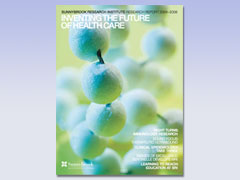Model Regeneration
Regenerative medicine—repairing or replacing damaged or diseased tissue and organs—is a research field with massive potential. Triggered by advances in the understanding of stem cells, it is an explosive nexus of cell biology, genetics, chemical engineering, materials science and surgery. Expectations have fluctuated wildly, from hope for easing the transplant organ shortage and curing Parkinson's, to despair over unchecked, cancerous cell growth, a common problem in regenerative medicine experiments. But progress has been real.
One model for innovation in the field is the Advanced Regenerative Tissue Engineering Centre (ARTEC) based at Sunnybrook Research Institute (SRI). Anchored by the commercial focus of four industrial partners and investment from the Ontario Research and Development Challenge Fund, ARTEC scientists at the University of Toronto and SRI have been solving tissue-engineering challenges since 2002. They're now looking to the future with a new focus thanks to incoming director Dr. Juan Carlos Zúñiga-Pflücker. Dr. Kimberly Woodhouse, associate director of ARTEC, says, "Juan Carlos brings the immunology expertise that will help move us forward. Immunology is a very important part of tissue engineering and regenerative medicine."
Beyond working on immune rejection in tissue and organ recipients, Zúñiga-Pflücker, a senior scientist at SRI, has an ambitious goal for ARTEC: he plans to engineer an artificial thymus. Located in the upper chest, the thymus produces T cells, white blood cells that enable the immune system to target and destroy disease-causing pathogens. "If you want to recreate T cell development within an organ, within a person, you need structural components—the nutrients, oxygen and blood vessels," explains Zúñiga-Pflücker, who holds a Canada Research Chair in Developmental Immunology. In vitro, these requirements are foregone, because serum media and reagents supplant them. In a living organism, he says, "You need a scaffold-containing environment to make the system transplantable."
Woodhouse, a scientist at SRI cross-appointed to the Department of Chemical Engineering and Applied Chemistry at U of T, constructs such scaffolds and other materials for soft tissue development. While continuing to develop new skin products for wound healing with ARTEC partner ApoPharma and fat tissue for reconstructive surgery after trauma, she'll work with Zúñiga-Pflücker to design and test products that could support vasculature in T cell development, including an artificial thymus. Additionally, with SRI researchers Drs. Albert Yee and Cari Whyne, and in conjunction with Elastin Specialties, Woodhouse's lab is developing materials that will support stem cell proliferation to repair degenerative spinal discs.
ARTEC excels at creating commercial synergy between academia and industry, but Woodhouse notes it also encourages industry-to-industry partnership. "ARTEC has been a nurturing environment for the companies to work with each other as well. Two of the corporate partners have combined technologies and are working collaboratively on a new project under the ARTEC umbrella," she says.
Though optimistic about ARTEC and tissue engineering, Woodhouse is realistic. Some regenerative medicine products take decades to develop. She and Rimon Therapeutics, an ARTEC partner with which she works, understand the need to bring products to market on a shorter timeline. Rimon's therapeutic wound dressing polymer, MI Theramer, took just four years to develop from conception to clinical trial.
Woodhouse appreciates the leveling effect of ARTEC's industrial partners: "They keep us grounded in terms of what's reasonable and what work may produce marketable products." At the same time, those companies encourage fundamental research and ask important scientific questions. Says Woodhouse, "We need to support basic research and commercialization; ARTEC has been fortunate in working with forward-thinking companies interested in both. If we don't encourage the continuum between the two, the next generation of scientific discovery—and industry-driven distribution of its products to patients—will be missing."
PDF / View full media release »





